Rasgueado is one of the essential techniques that gives flamenco guitar music its unique sound. The variety and nuance of rasgueado in modern flamenco can feel a bit overwhelming at first, but there are a few basic forms that can give you a foundation for exploring (and emulating) all the subtle differences you hear in recordings.
Before diving into some examples, it’s worth noting that there are often many ways to play a particular rasgueado pattern. Any one of these may be “correct” for a given situation. Depending on how you’re feeling at a particular point in a piece, you might play a rasgueado one way or another. The rhythm will be the same, but the way you produce it depends on the kind of inflection you want at the moment.
As you listen to flamenco artists, you’ll likewise hear that some artists gravitate toward particular forms and phrases. This is part of what creates the “soniquete” in their playing and makes their style distinct.
Four Basic Patterns
Most of the rasgueado you’ll see in tabs and videos on this site is a variation or combination of four basic patterns. If you’re new to flamenco fingering, p=thumb, i=index, m=middle, a=ring, and ch=pinky.
Four Stroke Rasgueado
This rasgueado is perhaps one of the most common in modern flamenco. It is made by playing a-m-i downstroke and then coming back up with i:
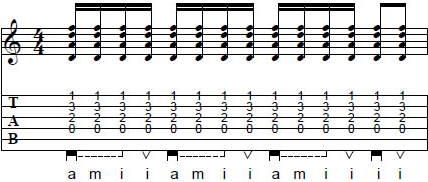
Five Stroke Rasgueado
This pattern adds the pinky (ch) in for an extra stroke. Though it comes up in modern playing in compound (i.e. long rolls) or syncopated (i.e. not straight 16th note) forms, in older styles of playing the five stroke rasgueado is more of a staple than its four stroke cousin:
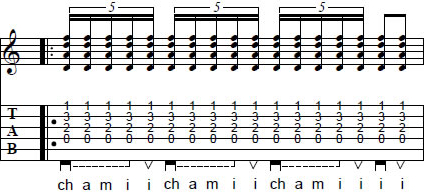
Triplet Rasgueado
This rasgueado is also very common. In contrast to the four- and five- stroke rasgueados above, the motion of the triplet rasgueado originates in the rotation of the wrist. The way I usually play it, it starts with an upstroke of the thumb and is then followed by downstrokes of a and i, but it can be started with any of these fingers to create a different sound:
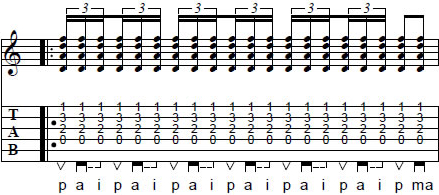
Double Triplet Rasgueado
This is perhaps the smoothest and subtlest of these rasgueados. It also easily has the most peculiar name. The “double” here is not in reference to paired triplets (in which case it would better apply to the rasgueado above), but rather to the fact that I find it easiest to think about this rasgueado as a triplet within a triplet. Each beat gets nine strokes. If you count each triplet as part of a larger triplet, it’s easier to keep track of the counts while you’re learning to coordinate your fingers. It is played only with i and a and, once learned, can create a smooth and fluid “rolling” effect:
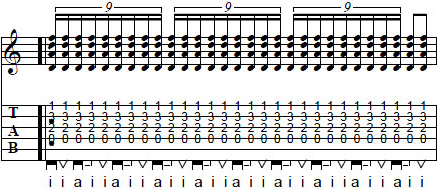
Exercises like these are a good start for developing the basic technique of rasgueado. In order to make that technique musical, however, we definitely need to add some variation to these root forms.
Variations
Which rasgueado variations you use will depend on, among other things, the palo you’re playing and your personal style. Some easy ways to vary the exercises discussed above are to vary the accents of the rasgueado in order to strengthen individual fingers or to start the rasgueado on different fingers. For example, instead of starting the four stroke rasgueado withthe ring finger (“a”) try starting it with the index finger (“i”) and then follow with the other fingers in sequence.
Once you understand and are comfortable with the basic forms, you can use them as building blocks to create the rhythmic patterns you need. Here are some examples culled from videos (and tabs) here on Ravenna Flamenco:
Four Stroke Rasgueado Variation
Example #1 is a slight variation of the four stroke rasgueado in a Tomatito falseta. The main melody uses the same right hand fingering as the example on the previous page, but I close the phrase with some minor syncopation and an accent on the last note (played with the m and a fingers together):
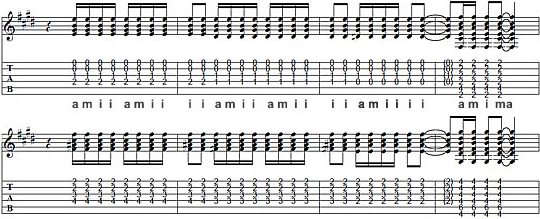
Five Stroke Rasgueado Variation
Example #2 demonstrates the five stroke rasgueado played across even 16th notes (i.e. 16ths grouped in “fours”). The first 16th note grouping is straightforward: ch-a-m-i. The second grouping, however, starts on the upstroke of i and then continues with ch a and m. The benefit of using a five stroke rasgueado here is 1) that the 16th notes are easier to play smooth and uniformly accented (i.e. not accented in groups of four) and 2) that you begin the following beat (the first note of the bottom staff) with a strong index down stroke that allows you to bring out the heavey accent. Although I’m not doing it in the video (why not I don’t know), this pattern also allows you to play a golpe on that first accented beat of the following phrase:
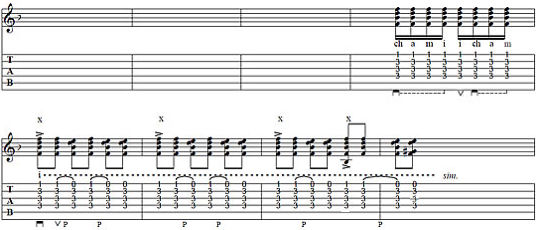
Triplet Rasgueado Variation
Example #3 shows a use of the triplet rasgueado in mid-phrase. These rasgueados are common at the end of a section or at the end of an entire song as the final wind-up. As seen here, however, they can also turn up lots of other places:

Double Triplet Rasgueado Variation
Example #4 ends with a double triplet rasgueado. This particular example is not the most common use of this rasgueado; you’re much more likely to encounter it in soleá and other slower palos. You can see here, however, the “rolling” quality of the double triplet rasgueado. Notice how this rasgueado “fades in.” The goal here is more to create a “texture” of sound than to play every note. You’ll also notice there’s an extra i down stroke after the two 9-beat groupings: this is so that the phrase can end on an i up stroke (which just happened to be my preference at the time):
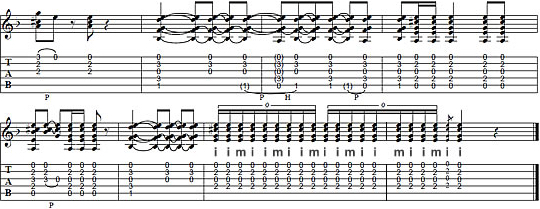
These variations are only a few of the countless possibilites with rasgueado you’ll encounter in flamenco. Techniques range widely from player to player. It’s well worth investigating other styles to find what’s right for the kind of sound you want to produce. The four basic techniques I’ve discussed above are by no means the only rasgueado techniques you’ll run into, but, as I hope I have shown, by being creative with how you accent and syncopate your playing, even with these few techniques you can generate a lot of versatility.
Rasgueado Practice Tips
As with the rasgueado patterns themselves, there are countless practice suggestions out there. Here are a few tips that have helped me in my pursuit of better rasgueado.
Think About Velocity
Crisp, clean rasgueado is less about playing fast than it is about playing distinctly. “Velocity” refers to the quickness of your individual fingers when you play, not to the speed or tempo of the music. Even when you play slow rasgueado, your fingers should strike the strings with the same quickness as when you play faster.
When you do play faster, if you strike each note with sufficient velocity, you will have fully sounded all the strings with the first finger of your rasgueado sequence before your second finger begins to strike. This makes for a clean, crisp sound. As you might guess, practicing high velocity rasgueado strokes at slower tempos makes the transition to clean rasgueado at faster tempos easier.
Practice Slowly
Slow practice of rasgueado may feel counterintuitive at first. It is, however, a good way to build an awareness of individual finger velocity. And it is also a way to focus on building strength in each finger: if you practice your rasgueados slowly, you can make sure that each finger strikes with equal volume. This pays off in dividends in terms of evenness and clarity when you play at speed. Practicing with a metronome can help keep you honest when it comes to tempo.
Stay Relaxed
Some degree of force is necessary for strong rasgueado, but it’s important to apply it in the right place: i.e. to the motion of the finger striking the strings. Tension on your hand (from trying to muscle through a rasgueado) applies force every which way, which can actually slow you down as a result of the muscles in your hand working against each other. In the triplet rasgueado, for example, your wrist should be very loose – the force in the rasgueado comes from the smaller movements of your fingers and thumb. If you tense your wrist up, you’ll lose the velocity it provides.
Be Persistent
Like much of the technique in flamenco playing, rasgueado is the kind of thing that takes time to get comfortable with and settle into. With a bit of persistence and focused practice, though, anyone can learn it.

